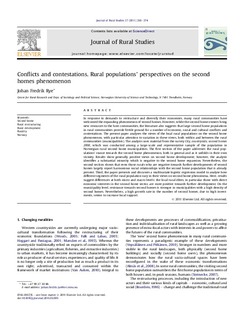| dc.description.abstract | In response to demands to restructure and diversify their economies, many rural communities have welcomed the expanding phenomenon of second homes. However, while the second home owners bring new resources to the host communities, the literature also suggests that large second home populations in rural communities provide fertile ground for a number of economic, social and cultural conflicts and contestations. The present paper analyses the views of the local rural populations on the second home phenomenon, with particular attention to variation in these views, both within and between the rural communities (municipalities). The analysis uses material from the survey City, countryside, second homes 2008, which was conducted among a large-scale and representative sample of the population in Norwegian rural second home municipalities. The first section of the paper addresses the rural populations’ stance towards the second home phenomenon, both in general and as it unfolds in their own vicinity. Results show generally positive views on second home development; however, the analysis identifies a substantial minority which is negative to the second home expansion. Nevertheless, the second section shows that even those rurals who are negative towards further developments of second homes largely report harmonious social relationships with the second home population that is already present. Third, the paper presents and discusses a multivariate logistic regression model to analyse how different segments of the rural population vary in their views on second home phenomena. Here, results suggest differences at both micro and macro levels: the local rural elites, in particular those with direct economic interests in the second home sector, are most positive towards further development. On the municipality level, resistance towards second homes is stronger in municipalities with a high density of second homes. Nevertheless, a high growth rate in the number of second homes, due to high investments, seems to increase local support. | nb_NO |

